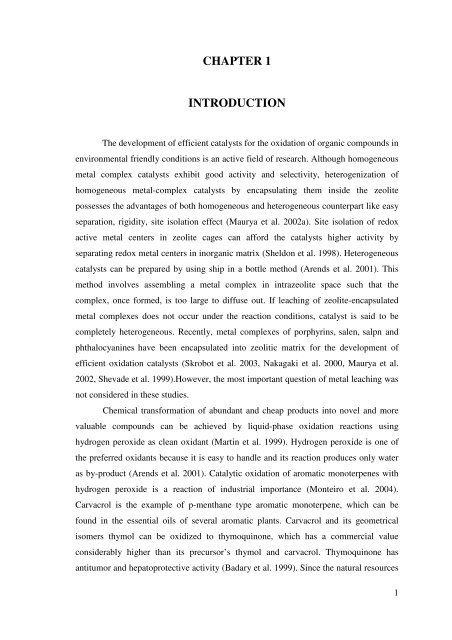the production of thymoquinone from thymol and carvacrol
the production of thymoquinone from thymol and carvacrol
the production of thymoquinone from thymol and carvacrol
Create successful ePaper yourself
Turn your PDF publications into a flip-book with our unique Google optimized e-Paper software.
CHAPTER 1<br />
INTRODUCTION<br />
The development <strong>of</strong> efficient catalysts for <strong>the</strong> oxidation <strong>of</strong> organic compounds in<br />
environmental friendly conditions is an active field <strong>of</strong> research. Although homogeneous<br />
metal complex catalysts exhibit good activity <strong>and</strong> selectivity, heterogenization <strong>of</strong><br />
homogeneous metal-complex catalysts by encapsulating <strong>the</strong>m inside <strong>the</strong> zeolite<br />
possesses <strong>the</strong> advantages <strong>of</strong> both homogeneous <strong>and</strong> heterogeneous counterpart like easy<br />
separation, rigidity, site isolation effect (Maurya et al. 2002a). Site isolation <strong>of</strong> redox<br />
active metal centers in zeolite cages can afford <strong>the</strong> catalysts higher activity by<br />
separating redox metal centers in inorganic matrix (Sheldon et al. 1998). Heterogeneous<br />
catalysts can be prepared by using ship in a bottle method (Arends et al. 2001). This<br />
method involves assembling a metal complex in intrazeolite space such that <strong>the</strong><br />
complex, once formed, is too large to diffuse out. If leaching <strong>of</strong> zeolite-encapsulated<br />
metal complexes does not occur under <strong>the</strong> reaction conditions, catalyst is said to be<br />
completely heterogeneous. Recently, metal complexes <strong>of</strong> porphyrins, salen, salpn <strong>and</strong><br />
phthalocyanines have been encapsulated into zeolitic matrix for <strong>the</strong> development <strong>of</strong><br />
efficient oxidation catalysts (Skrobot et al. 2003, Nakagaki et al. 2000, Maurya et al.<br />
2002, Shevade et al. 1999).However, <strong>the</strong> most important question <strong>of</strong> metal leaching was<br />
not considered in <strong>the</strong>se studies.<br />
Chemical transformation <strong>of</strong> abundant <strong>and</strong> cheap products into novel <strong>and</strong> more<br />
valuable compounds can be achieved by liquid-phase oxidation reactions using<br />
hydrogen peroxide as clean oxidant (Martin et al. 1999). Hydrogen peroxide is one <strong>of</strong><br />
<strong>the</strong> preferred oxidants because it is easy to h<strong>and</strong>le <strong>and</strong> its reaction produces only water<br />
as by-product (Arends et al. 2001). Catalytic oxidation <strong>of</strong> aromatic monoterpenes with<br />
hydrogen peroxide is a reaction <strong>of</strong> industrial importance (Monteiro et al. 2004).<br />
Carvacrol is <strong>the</strong> example <strong>of</strong> p-menthane type aromatic monoterpene, which can be<br />
found in <strong>the</strong> essential oils <strong>of</strong> several aromatic plants. Carvacrol <strong>and</strong> its geometrical<br />
isomers <strong>thymol</strong> can be oxidized to <strong>thymoquinone</strong>, which has a commercial value<br />
considerably higher than its precursor’s <strong>thymol</strong> <strong>and</strong> <strong>carvacrol</strong>. Thymoquinone has<br />
antitumor <strong>and</strong> hepatoprotective activity (Badary et al. 1999). Since <strong>the</strong> natural resources<br />
1
















